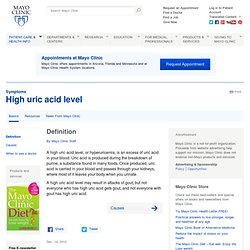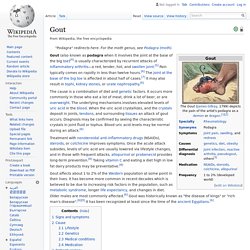

Molluscum contagiosum. Molluscum contagiosum (MC) is a viral infection of the skin or occasionally of the mucous membranes, sometimes called water warts.

It is caused by a DNA poxvirus called the molluscum contagiosum virus (MCV). MCV has no nonhuman-animal reservoir (infecting only humans). There are four types of MCV, MCV-1 to -4; MCV-1 is the most prevalent and MCV-2 is seen usually in adults. The virus that causes molluscum is spread from person to person by touching the affected skin. The virus may also be spread by touching a surface with the virus on it, such as a towel, clothing, or toys. Signs and symptoms[edit] Molluscum lesions on an arm. Molluscum contagiosum lesions are flesh-colored, dome-shaped, and pearly in appearance. Individual molluscum lesions may go away on their own and are reported as lasting generally from 6 weeks,[6] to 3 months.[7] The lesions may propagate via autoinoculation so an outbreak generally lasts longer.
Diagnosis[edit] Treatments[edit] Gout Symptoms, Diet, Treatment, Causes and Medication by MedicineNet. Uric acid. Uric acid is a heterocyclic compound of carbon, nitrogen, oxygen, and hydrogen with the formula C5H4N4O3.

It forms ions and salts known as urates and acid urates such as ammonium acid urate. Uric acid is a product of the metabolic breakdown of purine nucleotides. High blood concentrations of uric acid can lead to gout. The chemical is associated with other medical conditions including diabetes and the formation of ammonium acid urate kidney stones. Chemistry[edit] Uric acid is a diprotic acid with pKa1=5.4 and pKa2=10.3.[1] Thus in strong alkali at high pH, it forms the dually charged full urate ion, but at biological pH or in the presence of carbonic acid or carbonate ions, it forms the singly charged hydrogen or acid urate ion as its pKa1 is lower than the pKa1 of carbonic acid. What is Uric Acid? More than one out of three people with gout have not had their uric acid levels checked within the past five years. It’s normal for everyone to have at least some uric acid in their bodies. Too much of it can put people at risk for gout.
As cells die, they release substances called purines, which are also found in some foods. Purines break down and are eliminated as uric acid. Uric acid typically dissolves in the blood and then passes through the kidneys, where it is eventually eliminated through urine. Not everyone with hyperuricemia will get gout – but once it develops, it is likely to return, unless treated by medicine to lower uric acid levels. To avoid gout and other problems, uric acid levels should be 6.0 mg/dL or below. Most experts agree that lowering a person’s uric acid level can prevent the painful consequences of hyperuricemia – particularly gout.
High uric acid level. A high uric acid level, or hyperuricemia, is an excess of uric acid in your blood.

Uric acid is produced during the breakdown of purine, a substance found in many foods. Once produced, uric acid is carried in your blood and passes through your kidneys, where most of it leaves your body when you urinate. Gout. Gout (also known as podagra when it involves the joint at the base of the big toe)[4] is usually characterized by recurrent attacks of inflammatory arthritis—a red, tender, hot, and swollen joint.[5] Pain typically comes on rapidly in less than twelve hours.[6] The joint at the base of the big toe is affected in about half of cases.[7] It may also result in tophi, kidney stones, or urate nephropathy.[6] Treatment with nonsteroidal anti-inflammatory drugs (NSAIDs), steroids, or colchicine improves symptoms.

Once the acute attack subsides, levels of uric acid are usually lowered via lifestyle changes, and in those with frequent attacks, allopurinol or probenecid provides long-term prevention.[6] Taking vitamin C and eating a diet high in low fat dairy products may be preventative.[8] Gout affects about 1 to 2% of the Western population at some point in their lives. Signs and symptoms Cause Lifestyle Genetics Medical conditions.